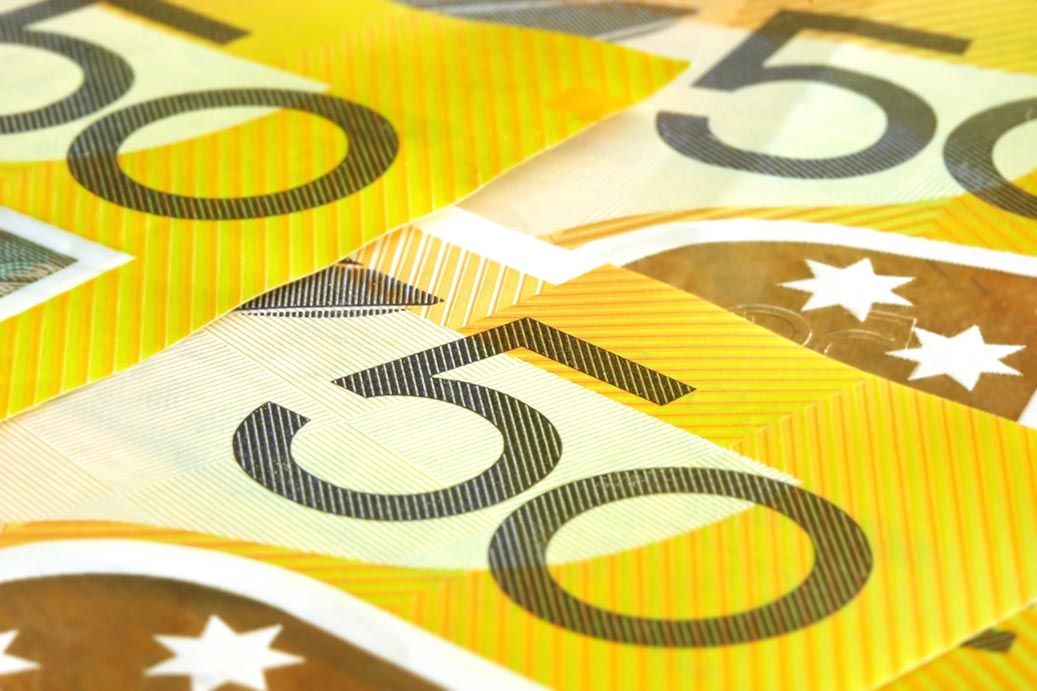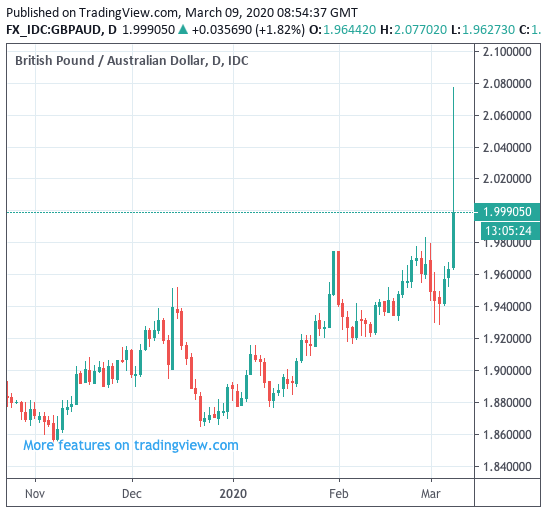Australian Dollar: GBP/AUD Breaks through 2.0 Barrier
- AUD in 'flash crash' in early Asia trade
- GBP/AUD jumps above 2.0 before retracing
- Slump in commodity prices hurts AUD
- Global supply chain disruption to impact AUD

Image © Robyn Mac, Adobe Stock
- GBP/AUD spot: 1.9873, +1.30%
- Bank transfer rates (indicative): 1.92-1.9340
- FX specialist rates (indicative): 1.96-1.97 >> More information
The Australian Dollar has been sold off in aggressive fashion at the start of a new week beset by concerns over the economic impact of the coronavirus, confirming the currency will retain a soft tone if market anxieties persist.
The Pound-to-Australian Dollar broke through the 2.0 mark on Monday, going as high as 2.0770 in early Asian trade when markets opened amidst thin liquidity. The spike proved temporary but as is so often the case with these 'flash crashes', markets fail to fully recover lost ground.
Hence, the Australian Dollar is still looking vulnerable and we are seeking GBP/AUD quoted at 1.9970 at the time of writing.
"The Australian Dollar is usually affected by prospects for global growth, especially in China. The slowdown to a virtual crawl in cases in China may also be playing a role. However, as the prospect for global growth deteriorates and commodity prices reflect the downturn in demand, downward pressure on the Australian Dollar could return," says Nelson Aston, Economist at St. George Bank in Sydney.
Over the weekend it was confirmed that the spread of the disease outside China continues and authorities continue to take measures to prevent its spread, which in turn potentially has significant economic costs. For instance, the decision to quarantine the population of Lombardy will have significant impacts for the Italian, and by extension Eurozone, economy.
However it will likely be a rapid decline in consumer sentiment right across the Northern Hemisphere that shifts the global economy into recession, as the consumer retreats we will see a sizeable decline in the purchase of goods and demand for travel while investment decisions are pared back by both individuals and businesses alike.
"Reflecting some of these fears, the Australian share market has declined recently. The ASX 200 fell almost 10% last week and opened lower by more than 5% on Monday. The disruption to Australian economic growth is likely to be substantial. The impact of the travel ban and other likely containment measures is set to have a permanent effect on some key domestic sectors, including recreational activities (such as the postponement of large commercial and entertainment events), airfares and accommodation," says Aston.
Above: GBP/AUD, showing the 'flash crash' spike in early Asia trade.
Coronavirus and oil market developments appear to be behind the decline in the Australian Dollar which tends to rise when market sentiment is buoyant and fall when markets run scared. The equation largely rests on the Australian Dollar's dependence on the export of commodities to China, when demand for these exports slumps demand for the Aussie Dollar naturally fades.
The Aussie is classed as a 'commodity currency', a market place is not looking constructive at present.
Oil prices slumped a whopping 30% when markets opened on Sunday night, a move that is a combination of fears of a global recession inspired by the coronavirus, but also largely owing to decisions taken by the oil cartel, OPEC. The OPEC+ meeting closed on Friday without agreement being reached on production cuts which would support oil prices during a global recession.
The current deal on oil production expires at the end of this month and it is expected all oil producing nations will boost production to make up for lost revenues triggered by the drop in oil prices.
"In response, Saudi Arabia, the world’s largest oil exporter, launched a price war," says Marshall Gittler, a strategist at BD Swiss. "Market talk was that the Kingdom might increase output to as much as 11mn b/d, vs the 9mn b/d that it was proposing under the agreement that it had offered (but Russia rejected)."
Saudi Arabia has announced plans to raise its oil production to more than 10mn barrels a day (b/d) from around 9.7mn b/d recently.
Its total capacity is estimated at around 12mn b/d.
"The kingdom will also offer unprecedented discounts of almost 20% in key markets, with the clear goal of taking market share away from Russia and inflicting pain on US shale producers. As a result, WTI collapsed 36% and Brent plunged 34%, the biggest move since 1991, when the surprisingly rapid end of the Gulf war caused oil prices to collapse," says Gittler.
Global Supply Chain Disruption is Major Negative for AUD
For the Australian Dollar, it is a severe slowdown in global trade that remains a key downside risk.
The United Nations reports that the slowdown of manufacturing in China due to the coronavirus (COVID-19) outbreak could result in a $US50 billion decrease in exports across global value chains.
According to estimates published by the United Nations Conference on Trade and Development (UNCTAD), the shutdown in China is disrupting world trade and has created a shortage of critical components for manufacturers outside of China .
China's manufacturing Purchasing Manager’s Index (PMI) for February fell 22 points to 37.5, its lowest reading since 2004 owing to an extended shutdown to industry as authorities grapple to squeeze the spread of the virus. The PMI reading reflects a sharp drop in output that the UNCTAD says implies a 2% reduction in exports on an annual basis.
"Assemblers which thought they could simply switch to local manufacturers discovered that their local manufacturers are also reliant on smaller components from China highlighting further problems with the supply chain," says John Mayer, analyst at brokerage SP Angel.
"In many cases critical components may rely on small amounts of rare earth elements which are often difficult to source, reliably, outside China highlighting how China controls certain markets through its dominance of raw materials," adds Mayer.
Australia relies heavily on Australian trade:
China is Australia's largest trading partner in terms of both imports and exports. Australia is China's sixth largest trading partner; it is China's fifth biggest supplier of imports and its tenth biggest customer for exports.
25% cent of Australia's manufactured imports come from China; 13% of its exports are thermal coal to China.











